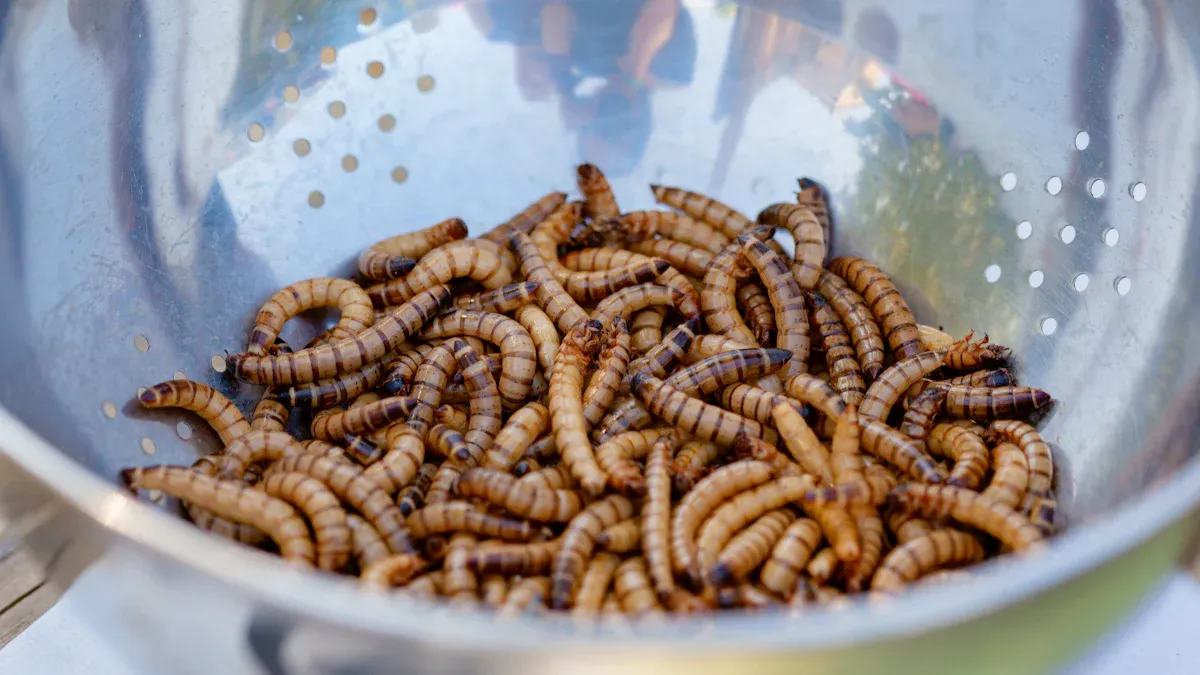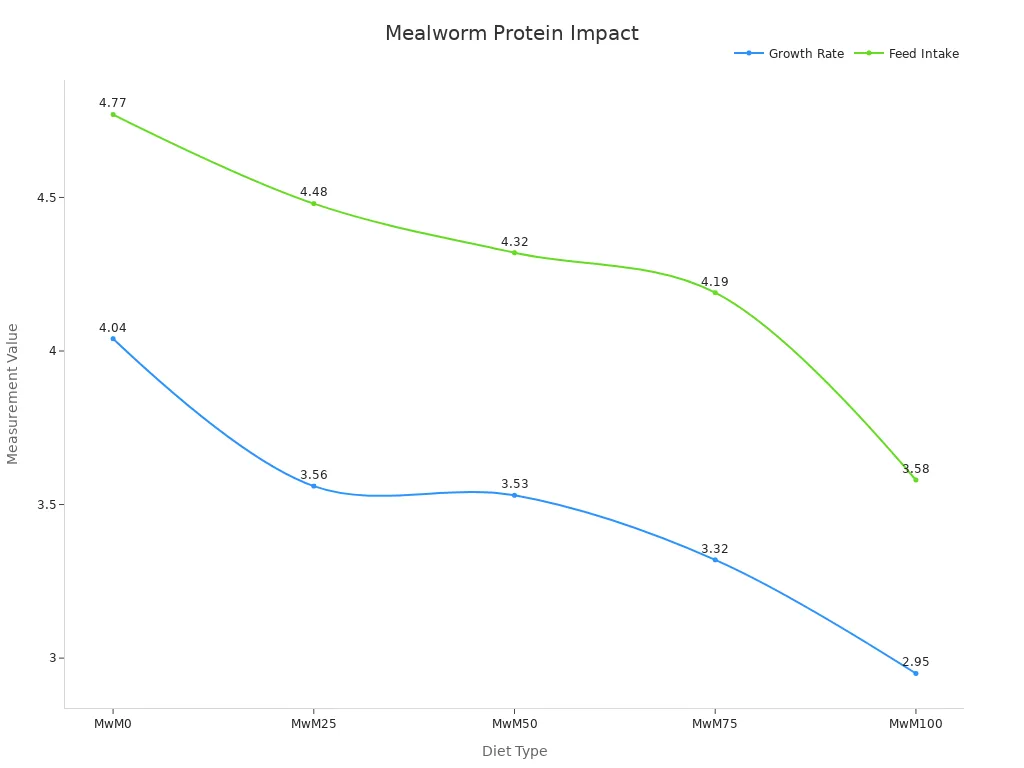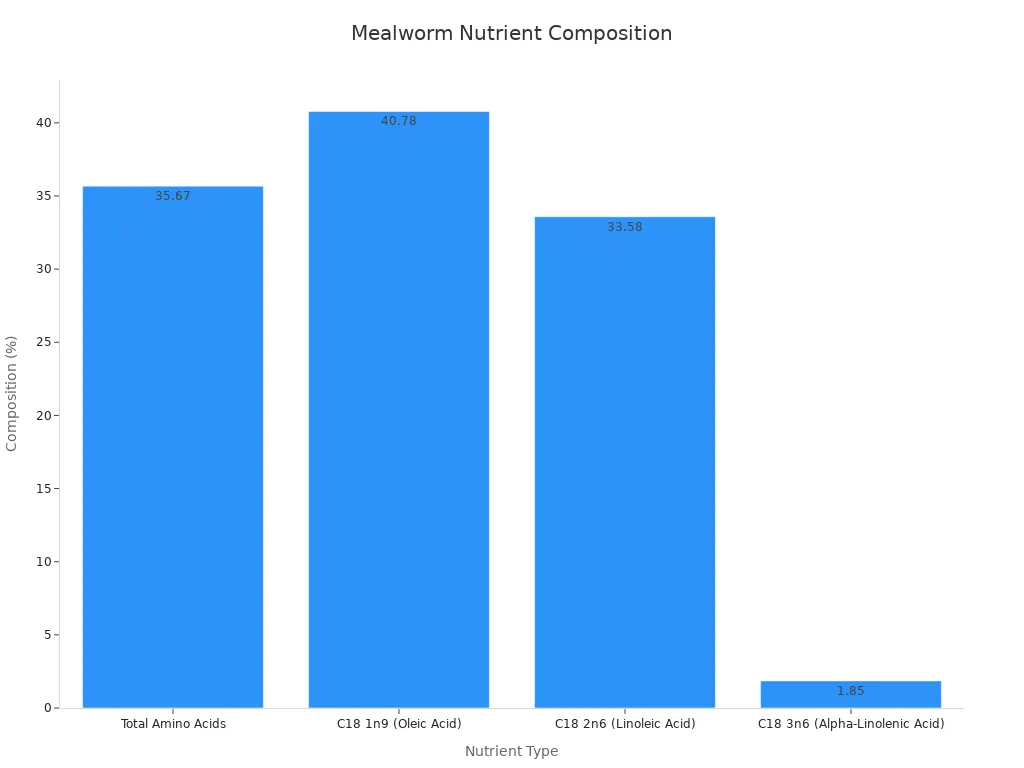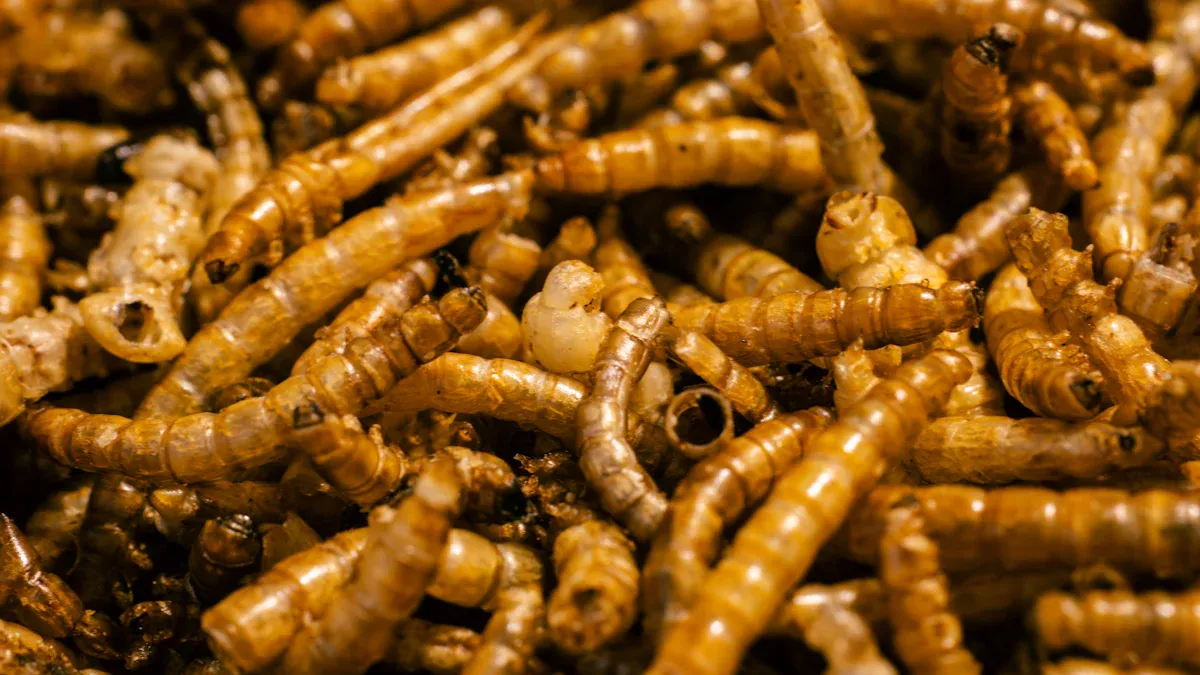
Dried mealworms for fish offer a powerhouse of nutrition. Their protein content ranges from 48% to 54%, surpassing many traditional feeds. Packed with essential trace elements like iron, zinc, and selenium, they support growth and vitality. Rich in healthy fats and amino acids, they enhance fish health, making them a superior choice for aquatic diets.
Key Takeaways
- Dried mealworms are high in protein, about 48% to 54%. This helps fish grow and gives them energy.
- They also have important fats, vitamins, and minerals. These nutrients keep fish healthy and boost their immune system.
- Using dried mealworms can make fish look better and more active. They are a better option than regular fish food.
Nutritional Benefits of Dried Mealworms
High Protein for Growth and Energy
Protein is the building block of life, and fish need plenty of it to grow and thrive. Dried mealworms for fish are an excellent source of protein, with levels reaching up to 49.1% on a dry weight basis. This high protein content supports muscle development, tissue repair, and overall energy. Fish fed with mealworms often show faster growth rates and improved weight gain compared to those on traditional diets.
For example, studies have shown that fish consuming diets with mealworm protein experience significant growth improvements. The table below highlights how different mealworm-based diets affect fish growth metrics like weight gain and feed conversion ratio (FCR):
| Diet Type | Final Body Weight (g) | Weight Gain (%) | Specific Growth Rate (%/day) | Feed Intake (g) | Feed Conversion Ratio (FCR) |
|---|---|---|---|---|---|
| MwM0 (Control) | 41.41 | 787.72 | 4.04 | 4.77 | 0.86 |
| MwM25 | N/A | N/A | 3.56 | 4.48 | N/A |
| MwM50 | N/A | N/A | 3.53 | 4.32 | N/A |
| MwM75 | N/A | N/A | 3.32 | 4.19 | N/A |
| MwM100 | N/A | N/A | 2.95 | 3.58 | N/A |

Mealworms also boast an impressive feed conversion ratio (FCR) of 2.2 kg/kg, making them an efficient and sustainable protein source. This efficiency rivals that of chicken and outperforms other livestock like pigs and cattle.
Essential Fatty Acids, Vitamins, and Minerals
Dried mealworms for fish are more than just a protein source. They are packed with essential fatty acids, vitamins, and minerals that contribute to a balanced diet. These nutrients play a vital role in maintaining fish health, supporting immune function, and enhancing energy levels.
For instance, mealworms contain high levels of oleic acid (40.78%) and linoleic acid (33.58%), which are crucial for healthy cell membranes and energy storage. The table below provides a breakdown of their nutrient composition:
| Nutrient Type | Composition (%) |
|---|---|
| Total Amino Acids | 35.67 |
| C18 1n9 (Oleic Acid) | 40.78 |
| C18 2n6 (Linoleic Acid) | 33.58 |
| C18 3n6 (Alpha-Linolenic Acid) | 1.85 |

These nutrients not only boost energy but also improve the immune system, helping fish resist diseases. Vitamins and minerals like selenium, zinc, and iron further enhance their overall health.
Enhancing Fish Health and Appearance
Feeding dried mealworms to fish does more than just support growth—it also improves their health and appearance. Studies have shown that mealworms can enhance immune responses, increase antioxidant activity, and even improve the quality of fish flesh.
For example, research on rainbow trout and Nile tilapia revealed that mealworm-based diets led to better flesh quality and brighter coloration. This is especially important for ornamental fish, where vibrant colors are highly valued. The table below summarizes findings from various studies:
| Study Title | Findings |
|---|---|
| Effect of Partial Dietary Replacement of Fishmeal by Yellow Mealworm (Tenebrio molitor) Larvae Meal on the Innate Immune Response and Intestinal Antioxidant Enzymes of Rainbow Trout (Oncorhynchus mykiss) | Improved immune response and increased antioxidant enzyme activity. |
| Graded Incorporation of Defatted Yellow Mealworm (Tenebrio molitor) in Rainbow Trout (Oncorhynchus mykiss) Diet Improves Growth Performance and Nutrient Retention | Enhanced growth performance and nutrient retention. |
| Partial Replacement of Soybean Meal by Yellow Mealworm (Tenebrio molitor) Meal Influences the Flesh Quality of Nile Tilapia (Oreochromis niloticus) | Positive effects on flesh quality and appearance. |
| Effects of the Replacement of Dietary Fish Meal With Defatted Yellow Mealworm (Tenebrio molitor) on Juvenile Large Yellow Croakers (Larimichthys crocea) Growth and Gut Health | Improved growth rates and gut health. |
| A Study of the Potential Effect of Yellow Mealworm (Tenebrio molitor) Substitution for Fish Meal on Growth, Immune and Antioxidant Capacity in Juvenile Largemouth Bass (Micropterus salmoides) | Enhanced growth, immune response, and antioxidant capacity. |
By incorporating dried mealworms into their diet, fish can achieve better health, resilience, and a more vibrant appearance.
Why Choose Dried Mealworms Over Other Fish Foods?
Comparing to Pellets and Flakes
Dried mealworms for fish stand out when compared to traditional pellets and flakes. While pellets and flakes are convenient, they often lack the rich nutritional profile that mealworms provide. Mealworms are packed with high-quality protein and essential amino acids, making them a superior choice for promoting fish growth and energy.
- Mealworms contain higher protein quality than soybean meal, a common ingredient in pellets.
- Their amino acid composition rivals fish and poultry meal, offering a balanced diet for fish.
- Unlike pellets, mealworms provide all essential amino acids, ensuring optimal health and vitality.
Additionally, mealworms are easier to digest. Studies on Nile tilapia show that mealworms have the highest apparent digestibility coefficient compared to other insect meals. This means fish can absorb nutrients more efficiently, leading to better growth and overall health.
Advantages Over Live Foods
Live foods like worms or small crustaceans are often used in fish diets, but dried mealworms offer several advantages. First, they eliminate the risk of introducing parasites or diseases that live foods may carry. Second, they are far more convenient to store and handle.
- Mealworms reared on specific diets have better feed conversion ratios, making them a more efficient protein source.
- Their dry matter digestibility reaches up to 70.38%, outperforming many live food options.
Dried mealworms also provide consistent nutritional value, unlike live foods, which can vary depending on their source. This consistency ensures fish receive the same high-quality nutrients with every feeding.
Sustainability and Shelf Life
Dried mealworms for fish are not just nutritious—they’re also environmentally friendly. Their production requires significantly less water and land compared to traditional fishmeal or livestock feed.
- Mealworms need only 4341 m³ of water per ton, far less than fishmeal or beef production.
- Their carbon footprint is low, emitting just 20.4 kg CO2-eq per kilogram of protein.
- They convert feed into protein efficiently, reducing nitrogen waste and environmental impact.
Mealworms also help reduce pressure on wild fish stocks by serving as a sustainable alternative to fishmeal. Their long shelf life makes them cost-effective and easy to store, ensuring freshness without refrigeration. This combination of sustainability and convenience makes dried mealworms an excellent choice for aquaculture enthusiasts.
Feeding Dried Mealworms to Different Fish Species

Best for Carnivorous and Omnivorous Fish
Dried mealworms are a fantastic choice for carnivorous and omnivorous fish. These fish thrive on protein-rich diets, and mealworms deliver just that. Packed with high-quality protein and essential amino acids, they support muscle growth and energy. Carnivorous species like cichlids and arowanas benefit greatly from the dense nutrients in mealworms. Omnivorous fish, such as goldfish and guppies, also enjoy the added variety and nutrition in their meals.
Studies show that up to 25% of traditional feed can be replaced with mealworms without affecting fish yield. This substitution not only supports growth but also improves nutrient digestibility. For aquarists, mealworms offer a simple way to enhance their fish’s diet while ensuring optimal health.
Suitable for Freshwater and Saltwater Species
Dried mealworms for fish are versatile and work well for both freshwater and saltwater species. Freshwater fish like koi and bettas enjoy the natural taste and texture of mealworms. Saltwater species, including clownfish and tangs, also benefit from the rich fatty acids and vitamins they provide.
Aquaculture studies highlight their effectiveness across diverse species. For example, European sea bass juveniles fed mealworms showed improved growth and nutrient absorption. In shrimp farming, replacing fish meal with mealworms led to increased body weight and lipid content. This adaptability makes mealworms a reliable option for various aquatic environments.
Tips for Feeding Picky Eaters
Some fish can be picky eaters, but mealworms often win them over. Their natural flavor and crunchy texture appeal to even the most selective fish. To encourage feeding, try soaking the mealworms in tank water for a few minutes. This softens them and releases a scent that attracts fish.
Adding mealworms gradually to the diet can also help. Start by mixing them with the fish’s regular food. Over time, increase the proportion of mealworms. This method works well for introducing new foods without overwhelming the fish.
For an extra boost, consider mealworms enriched with probiotics. These enhance nutritional value and promote health through beneficial metabolites, making them even more appealing to picky eaters.
Practical Feeding Tips for Dried Mealworms
Preparation and Serving Guidelines
Preparing dried mealworms for fish is simple and effective when following a few key steps. To soften the texture and enhance palatability, soak the mealworms in warm water for 5 minutes. Use a 1:1 ratio of mealworms to water, ensuring the water temperature reaches 100 °C before starting the timer. This process makes the mealworms easier for fish to digest and releases natural aromas that attract them.
For smaller fish, crush or chop the mealworms into bite-sized pieces. This ensures they can consume the food comfortably. Larger fish can enjoy whole mealworms as part of their diet. Always serve mealworms in moderation to avoid overfeeding and maintain water quality in the tank.
Feeding Frequency and Portion Sizes
Feeding dried mealworms to fish requires balance. Most fish thrive on two feedings per day, spaced evenly to prevent overeating. Adjust the portion size based on the fish species and their dietary needs. A general rule is to offer an amount they can consume within 2–3 minutes.
For carnivorous fish, mealworms can make up 25–50% of their diet. Omnivorous fish benefit from a mix of mealworms and plant-based foods. Monitor your fish’s behavior and appearance to ensure they are receiving the right amount of nutrients.
Proper Storage for Freshness
Storing dried mealworms correctly preserves their nutritional value and prevents spoilage. Keep them in an airtight container in a cool, dry place. Avoid exposure to moisture, as high humidity can lead to microbial growth and nutrient loss.
Studies show that drying methods like freeze drying or vacuum oven drying reduce moisture content to levels between 0.87% and 9.83%. This range is ideal for long-term storage. Properly stored mealworms retain their protein, fatty acids, and vitamins, ensuring your fish receive the best nutrition every time.
Dried mealworms offer unmatched nutrition, versatility, and convenience for fish diets. They boost growth, improve health, and enhance appearance. Studies confirm their effectiveness, with insect-based diets showing the highest growth and survival rates:
| Diet Treatment | Growth Performance | Survival Rate | Condition Factor |
|---|---|---|---|
| L0 (Insect Meal) | Highest | Highest | Highest |
| Control | Lowest | Lowest | Lowest |
| L3, L7 (Insect Meal) | Similar and statistically significant | Highest | Higher than control |
Switching to mealworms can also reduce environmental impact. For example:
- Replacing fish meal with mealworms in shrimp farming increases body weight.
- Up to 25% of traditional feed can be substituted without yield loss.
Make the switch today and see the difference in your fish’s vitality!
Article author: Felix
FAQ
Are dried mealworms safe for all fish species?
Yes, dried mealworms are safe for most fish species. Their natural nutrients make them suitable for freshwater and saltwater fish, including carnivorous and omnivorous types. 🐟
How should dried mealworms be stored?
Store dried mealworms in an airtight container in a cool, dry place. This keeps them fresh and prevents moisture from reducing their nutritional value.
Can dried mealworms replace traditional fish food entirely?
Dried mealworms can replace up to 25–50% of traditional fish food. They complement other feeds, ensuring a balanced diet for optimal fish health and growth.


